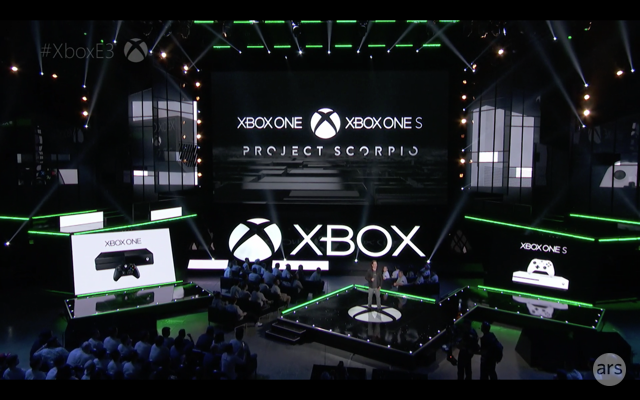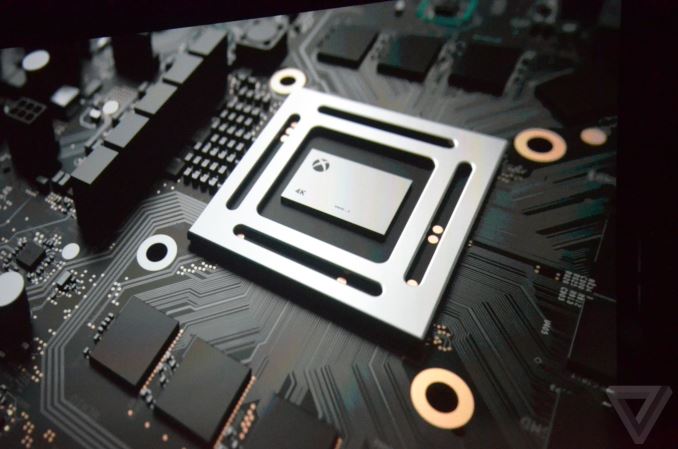Microsoft Teases Project Scorpio for 2017: 8 cores, 6 TeraFLOPs, Backwards Compatible with Xbox. Zen or Jaguar?!
by Ian Cutress on June 13, 2016 2:02 PM EST- Posted in
- Microsoft
- Gaming
- Trade Shows
- Consoles
- E3

This news piece contains speculation, and suggests silicon implementation based on released products and roadmaps.The only elements confirmed for Project Scorpio are the eight cores, >6 TFLOPs, 320 GB/s, it's built by AMD, and it is coming in 2017. If anyone wants to officially correct any speculation, please get in touch.
Here’s an announcement at E3 for you. Microsoft just announced Project Scorpio, an internal project to develop the next generation Xbox set to be released in 2017. Project Scorpio is to be backwards compatible with Xbox One, and seems to be directly in line to compete with whatever Sony are supposedly releasing in the near future. But here’s some specifications for you that has my mind in a twist.
In the presentation, Microsoft states that the Project Scorpio SoC will have eight cores, up to 320 GB/s of memory bandwidth, and over 6 TeraFLOPs of power. To put this into context, this is more processing power than the recently announced AMD RX 480 GPU using a GCN 4 based architecture, set to be launched later this month. Microsoft specifically announced that Project Scorpio is to be launched next year, which puts a few things together worth mentioning.
By this time next year, we expect AMD’s Zen microarchitecture to be in full swing, and AMD has already showcased a silicon sample of an 8-core Zen processor. However, the current Xbox line relies on AMD’s ‘cat’ core architecture, which according to current AMD roadmaps doesn’t seem to feature anywhere for 2017. Without a direct confirmation, it’s hard to tell if Project Scorpio is the same Jaguar cores as the Xbox One, or the newer Zen microarchitecture. I would assume we won’t find out until later next year.
| Microsoft Console Specification Comparison | ||||||||||||||
| Xbox 360 | Xbox One | Project Scorpio | ||||||||||||
| CPU Cores/Threads | 3/6 | 8/8 | 8 / ? | |||||||||||
| CPU Frequency | 3.2GHz | 1.6GHz (est) | ? | |||||||||||
| CPU µArch | IBM PowerPC | AMD Jaguar | ? | |||||||||||
| Shared L2 Cache | 1MB | 2 x 2MB | ? | |||||||||||
| GPU Cores | 768 | ? | ||||||||||||
| Peak Shader Throughput | 0.24 TFLOPS | 1.23 TFLOPS | >6 TFLOPs | |||||||||||
| Embedded Memory | 10MB eDRAM | 32MB eSRAM | ? | |||||||||||
| Embedded Memory Bandwidth | 32GB/s | 102GB/s | ? | |||||||||||
| System Memory | 512MB 1400MHz GDDR3 | 8GB 2133MHz DDR3 | ? | |||||||||||
| System Memory Bus | 128-bits | 256-bits | ? | |||||||||||
| System Memory Bandwidth | 22.4 GB/s | 68.3 GB/s | 320 GB/s | |||||||||||
| Manufacturing Process | 28nm | ? | ||||||||||||
On the GPU side, the current Xbox One uses a 16 CU implementation in the SoC, with two disabled giving 14 CUs. We already know that AMD’s RX 480, running at 5 TFLOPs and built on Global Foundries 14nm FinFET process, runs in at 36 CUs. So Project Scorpio will have easily have more CUs than Xbox One, and judging by the shots in the video, the die size is relatively small. The Xbox One was built on TSMC’s 28nm HP process. At this point it’s still not confirmed if this is an AMD win, however judging by the comments towards backwards compatibility and SoC integration (where CPU and GPU are on the same silicon (or package)), all fingers would point in that direction.
| AMD Radeon GPU Specification Comparison | ||||||
| AMD Radeon RX 480 | AMD Radeon R9 390X | AMD Radeon R9 390 | AMD Radeon R9 380 | |||
| Stream Processors | 2304 (36 CUs) |
2816 (44 CUs) |
2560 (40 CUs) |
1792 (28 CUs) |
||
| Texture Units | (Many) | 176 | 160 | 112 | ||
| ROPs | (A Positive Integer) | 64 | 64 | 32 | ||
| TFLOPs (FMA) | >5 TFLOPs | 5.9 TFLOPs | 5.1 TFLOPs | 3.5 TFLOPs | ||
| Boost Clock | >1.08GHz | 1050MHz | 1000MHz | 970MHz | ||
| Memory Clock | 8Gbps GDDR5 | 5Gbps GDDR5 | 5Gbps GDDR5 | 5.5Gbps GDDR5 | ||
| Memory Bus Width | 256-bit | 512-bit | 512-bit | 256-bit | ||
| VRAM | 4GB/8GB | 8GB | 8GB | 2GB | ||
| Transistor Count | ? | 6.2B | 6.2B | 5.0B | ||
| Typical Board Power | 150W | 275W | 275W | 190W | ||
| Manufacturing Process | GloFo 14nm FinFET | TSMC 28nm | TSMC 28nm | TSMC 28nm | ||
| Architecture | GCN 4 | GCN 1.1 | GCN 1.1 | GCN 1.2 | ||
| GPU | Polaris 10? | Hawaii | Hawaii | Tonga | ||
| Launch Date | 06/29/16 | 06/18/15 | 06/18/15 | 06/18/15 | ||
| Launch Price | $199 | $429 | $329 | $199 | ||
The memory bandwidth of Project Scorpio, 320 GB/s, is also relatively interesting given the current rates of the RX 480 topping out at 256 GB/s. The 320 GB/s number seems round enough to be a GPU only figure, but given previous embedded memory designs is likely to include some form of embedded memory. How much is impossible to say at this point.
AMD has stated that the RX 480 is a VR Gaming capable card, so given what we've said about the Xbox One S tackling VR, it's clear that Project Scorpio is right on the money. AMD's business plan as of late is to expand its custom SoC business, and thus sticking Zen and a GCN 4 based architecture on a combined package or die for Microsoft makes a lot of sense. At the RX 480 announcement, it was stated that AMD wants to power the first 100 million VR users, and this would help towards that goal.
It's worth noting that this news piece contains a decent amount of speculation based on knowledge of the market, and the only elements confirmed for Project Scorpio are the eight cores, >6 TFLOPs, 320 GB/s, and it is coming in 2017. If anyone wants to officially correct any speculation, please get in touch.
Sources: Ars Technica (Carousel Image), Verge Live Blog (Video Screen Capture)
Additional: We can confirm that Scorpio will be an AMD based design, as expected.











101 Comments
View All Comments
Krysto - Tuesday, June 14, 2016 - link
You'll have the same graphics as you do now, but with 4x the pixels, which should be doable because you get like 4.5x the performance with the new console. I don't know how "techies" still can't get this easy calculation yet.MapRef41N93W - Saturday, June 25, 2016 - link
Not sure how people like you still fail to realize that FLOPs don't directly translate to performance in video games. The R9 290 is 4.8 AMD TFLOPs and the Fury X is 8.6 TFLOPs. The Fury X is not even close to that much faster in video games than an R9 290.taisserroots - Monday, June 13, 2016 - link
You sure they didn't post CPU+GPU teraflop performance?extide - Monday, June 13, 2016 - link
Even if they did, the CPU would add so little that it would hardly matter.Shadowmaster625 - Monday, June 13, 2016 - link
In order to maintain compatability, will it not require the same sort of eSRAM implementation? If so then maybe they are playing number games to arrive at 320GB/s. Could it be a 100 GB/s eSRAM interface combined with a 200 GB/s GDDR5 interface, or using some goofy sum of squares math, maybe 250GBs + 100GB/S = 320GB/s? Also, doesnt the CPU have some number of GFLOPS of floating point performance? Could this be a 5.5TFLOP GPU combined with a few hundred GFLOP CPU to total 6 TFLOP? At any rate, it is probably going to require 40CU, which means a 44 or even a 48CU die for yields.DanNeely - Monday, June 13, 2016 - link
CPU cores are only in the tens of GFLOPs/core. Even if they are doing some sort of shenanagens with memory bandwidth, adding the CPU power to the GPU power ends up as rounding error in a TFLOP number.zepi - Monday, June 13, 2016 - link
8-core cpu running at 3GHz using avx512 can in theory achieve 32 single precision operations per cycle. Ie. 3GHz Zen would be 768Gflops (on paper) and 4GHz would be 1 TFlops!Still not much compared to gpu, but enough to be more than just rounding error compared to ~5 TFLOPS GPU.
http://stackoverflow.com/questions/15655835/flops-...
BillyONeal - Tuesday, June 14, 2016 - link
The only hardware implementing AVX512 is Xeon Phi; you're not going to see that on "cat" cores.blppt - Tuesday, June 14, 2016 - link
Plus, even i7 level AVX2 turns your cpu into a nuclear furnace---can only imagine the heat problems for the set top box console.nikon133 - Monday, June 13, 2016 - link
I was thinking the same. Pretty sure it will need to have eSRAM, and knowing Microsoft, there will be / already is marketing spin around that. Remembering how keen they were on tossing eSRAM's theoretical max. contribution into X1 performance, and describing X1 success with vague things like how many miles, bullets, headshots and whatnot have X1 gamers achieved - I'm expecting the same will continue.Eventually, will not be surprised if Scorpio and Neo are pretty much the same hardware, with addition of eSRAM on Scorpio's side. Using same SoC makes sense from economy perspective, AMD will do cheaper one SoC selling in greater numbers, than two SoCs each doing only half as much. I even wouldn't be surprised if MS and Sony make some secret pact under the table and stop competing on hardware - they both got bitten by underperforming yet overpriced hardware. Yes one will end up with upper hand, but risk of having bad marketing and poorer multiplatform titles for the whole generation is quite a risk to take, if it can be avoided; I will not be surprised if they agree on standardized SoC and compete with accessories and exclusive titles, while securing equality for 3rd party games.